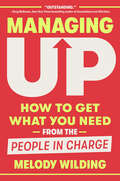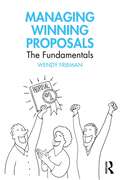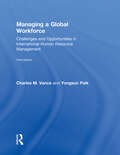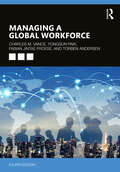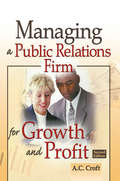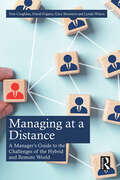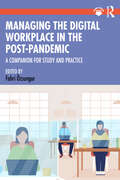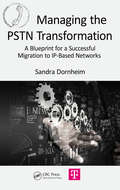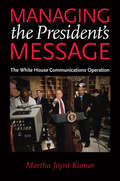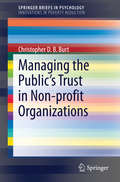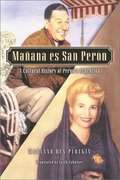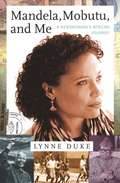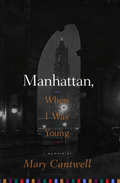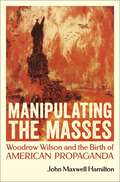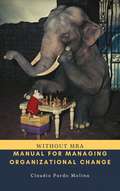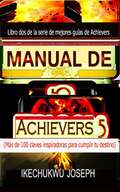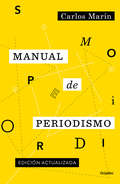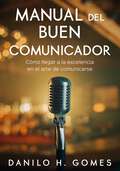- Table View
- List View
Managing Up (20-Minute Manager Series)
by Harvard Business ReviewYour boss plays an important role in your career. So how do you navigate this delicate, significant professional relationship without playing political games or compromising your character? Managing Up offers concise, expert tips on: Understanding your manager's priorities and pressures Setting a positive tone for the relationship Managing expectations-and egos Earning trust and respectAbout HBR's 20-Minute Manager Series:Don't have much time? Get up to speed fast on the most essential business skills with HBR's 20-Minute Manager series. Whether you need a crash course or a brief refresher, each book in the series is a concise, practical primer that will help you brush up on a key management topic.Advice you can quickly read and apply, for ambitious professionals and aspiring executives-from the most trusted source in business. Also available as an ebook.
Managing Up: How to Get What You Need from the People in Charge
by Melody WildingAn indispensable guide to navigating power dynamics, building effective relationships with higher-ups, and earning more authority, freedom, and confidence at work—from one of today&’s &“most innovative career coaches&” (Insider).&“Outstanding. Wilding's scripts and strategies show us a better way to get ahead at work.&”—Greg McKeown, New York Times bestselling author of Essentialism and Effortless Do you feel vulnerable to the whims of your boss, peers, or internal politics, pushing through each day with a nagging undercurrent of anxiety? Maybe you&’re micromanaged, interrupted in meetings, saddled with busy work, or overlooked for career opportunities. But what if you could subtly teach those above you to value your ideas and treat you with respect—without ever changing your job title?Human behavior professor and award-winning executive career coach Melody Wilding has helped thousands of clients advocate for their needs at work while navigating the minefield of office politics. In this clear, tactical guide, Wilding shows you how to operate from a position of power—even if you lack formal authority—to build the emotional intelligence, relational capital, and negotiation savvy to succeed in a world of competing stakeholders and remote work. Drawing on real-life client stories and the latest research on trust and persuasion, Managing Up distills a vital skillset into ten key conversations, including:• The Alignment Conversation: How can I get in my boss&’s head to understand their needs, motivations, and goals?• The Styles Conversation: Will I earn more respect from my manager if I get to the point quickly, or should I try swapping stories and building rapport? • The Boundaries Conversation: How do I say no and push back with tact when my manager saddles me with yet another task?Packed with time-tested strategies, detailed scripts, and transformative insights, this book is a must-read for professionals of all levels ready to reclaim control of their careers.
Managing Winning Proposals: The Fundamentals
by Wendy FriemanPreparing a proposal for a contract or a grant can be an overwhelming and extraordinarily complex process, but regardless of the proposal type or sector, certain truths always pertain. This book walks the proposal manager through the steps that are essential and common to every single proposal and ensure a foundation for winning. Many proposal management books are of little use, particularly to a first‑time proposal manager, owing to their broad scope and unrealistic assumptions about resources, including time, expertise and information. This book provides actionable, concrete steps for the activities that underpin all successful proposals, providing a step‑by‑step description of how to make a proposal compliant and compelling. The premise of this book, based on the author’s hands‑on experience in multiple proposal roles for over three decades, is that proposals do not go off the rails owing to an inability to implement advanced techniques and complicated processes. They fail because of inattention to fundamental activities. Other business books cover some of these fundamental activities. However, proposals differ because of their tight constraints: deadlines, the need for perfect compliance with detailed instructions, fierce competition for limited funds, the consequences of not winning and the stress that inevitably accompanies the process. Focusing solely on the preparation of the written proposal document and not on sales, negotiation, marketing, or customer interaction, this book dives into the details of the tasks facing the person actually accountable and responsible for preparation and delivery of the proposal. Proposal managers of all levels, from first‑timers to seasoned pros looking to polish their skills, as well as those who participate in the proposal process but are not intimately familiar with it – artists, technical writers, project managers, accountants and others – will benefit from the processes and tools described in this book.
Managing a Chinese Partner
by Lub Bun ChongFrom 2007 to 2009, French food and beverage giant Danone and Chinese entrepreneur Zong Qinghou who is ranked number one on Forbes' China Rich List 2012 were embroiled in a highly rancorous dispute over their joint venture, Hangzhou Wahaha. It transpired that even French President Sarkozy reportedly found time in his 2007 three-day state visit to China to discuss the 'Wahaha' dispute with his Chinese counterpart, President Hu. Behind the melodrama of the 'Wahaha' dispute lies an important lesson for foreign companies in China. As a result of the global shift in power, the imperative for a foreign company to manage its Chinese Partner has never been stronger since China re-opened its doors for business in 1978. By drawing on the experiences of Danone, Nestle, Coca-Cola and SABMiller, this book provides an insight into why, as well as, how the managing of a Chinese Partner can deliver sustainable value for a joint venture in China. "
Managing a Global Workforce
by Yongsun Paik Charles M. VanceThis new edition of Managing a Global Workforce provides balanced and contemporary coverage of human resource management in the international marketplace. Directed at future general managers and international executives, rather than HR specialists, it is designed to help students as well as professionals recognize the critical human resource issues underlying the cultural and economic challenges they face.
Managing a Global Workforce: Challenges And Opportunities In International Human Resources Management
by Yongsun Paik Fabian Jintae Froese Charles Vance Torben AndersenManaging a Global Workforce examines important human resource management issues and practices in today’s global marketplace, helping current and future managers and leaders, regardless of nationality, in making effective human talent management decisions for optimal organizational performance. This fourth edition includes significant updates to reflect recent global developments affecting the management of global HRM, including the following: • The COVID-19 pandemic and its impact on new work expectations/arrangements; • The Great Resignation; • AI and automation; • Managing diversity, equity, and inclusion; • Climate change; • Emerging economies; and • CSR/ethics/sustainability The new edition also includes several new opening and closing brief cases to promote applied reflection and discussion, as well as updated references to important research. With its practical, real-world emphasis, including frequent use of current examples, the text also serves as a useful resource for guiding the global workforce management and decision-making of current and future general managers and human resource practitioners. This book is essential reading for general graduate and undergraduate business students, as well as those in specialty programs in International Business and Human Resources.
Managing a Public Relations Firm for Growth and Profit
by Alvin C CroftThe one-of-a-kind how-to book that puts effective agency management strategies at your fingertipsThe classic text that describes in detail how to successfully manage and market a public relations firm, has been completely updated with three new chapters and is now more than 50% longer. This one-of-a-kind new edition is bursting with creative tips, instructions, philosophies, theories, and guidance, all to help you steer your firm to success. It demonstrates how to market, promote, and sell a firm to attract, win, and hold the right clientele. You will learn how to manage a new or existing firm so that it is productive and profitable and has a long-range future. Information in Managing a Public Relations Firm for Growth and Profit, Second Edition is based on author A. C. Croft&’s extensive experience in the field-almost twenty years as a consultant to PR firm principals and more than 25 years as an employee or principal of three medium-sized successful PR agencies. Croft begins each chapter with a brief profile of a seasoned and successful PR firm principal from a mid-sized firm. These professionals tell of their successes and also relate early mistakes that you would do well to avoid. The text includes tables and figures to make data easily understood.The extensively revised Managing a Public Relations Firm for Growth and Profit, Second Edition discusses pertinent topics such as: keys to new business success developing a marketing plan serving clients communication to prospects management strategies for success installing efficient systems and procedures managing staff productivity forecasting income management systems and procedures managing profitability client and agency budgeting recruiting, training, and retaining staff crisis planning planning the future of your firmCovering everything from billing practices and self-promotion to the use of computers and student interns, Managing a Public Relations Firm for Growth and Profit, Second Edition is one guide you are sure to refer to again and again for practical advice. It is must reading for owners of small- and medium-sized PR firms; senior managers of small, medium, and national firms who wish to expand their management knowledge and ability or who are considering starting their own firm; lower-level staff members who want to increase their knowledge of agency management; and university public relations professors who would like to include a primer on PR firm management in their classes.
Managing at a Distance: A Manager’s Guide to the Challenges of the Hybrid and Remote World
by Tom Coughlan David J. Fogarty Gary Bernstein Lynda WilsonThe world of hybrid and remote management is a territory that has yet to be completely explored—this book provides some simple navigational aids to help managers and leaders find their way.Research indicates that over 56% of college graduates currently work either remotely or in a hybrid arrangement, while prior to the pandemic, less than 5% of working hours were remote. How to manage remote and hybrid workers has rapidly become a significant challenge, and one that often requires new policies and organizational restructuring. The remote work handbooks available are tactical, which can be helpful for day-to-day decisions but not to tackle larger issues and initiatives. This book presents a fully formed, research-backed strategic framework: more than a vehicle to the future, it will help leaders to understand where they are now and what is happening around them to change the landscape, and to decide where they want to be.Speaking to senior executives and team leaders, as well as business students, this book will become the preferred tool for the development and evaluation of remote and hybrid management policy and strategy across industries.
Managing the Digital Workplace in the Post-Pandemic: A Companion for Study and Practice
by Fahri ÖzsungurManaging the Digital Workplace in the Post-Pandemic provides a cutting-edge survey of digital organizational behaviour in the post-pandemic workplace, drawing from an international range of expertise. It introduces and guides students and practitioners through the current best practices, laboratory methods, policies and protocols in use during these times of rapid change to workplace practices. This book is essential reading for students, researchers and practitioners in business and management. The book draws on global expertise from its contributors while being suitable for class and educational use, with each chapter including further reading, chapter summaries and exercises. Tutors are supported with a set of instructor materials that include PowerPoint slides, a test bank and an instructor's manual. This text covers a wide range of themes in this fast-developing field, including: The effect of the pandemic on the digital workplace Gender and cyberbullying in the context of the digital workplace Digital ergonomics and productivity Digital conflict management
Managing the PSTN Transformation: A Blueprint for a Successful Migration to IP-Based Networks
by Sandra DornheimWhile there are many scholarly books and papers that cover the technical issues behind the public switched telephone network (PSTN) migration, few books describe exactly how to manage the migration process economically. Filling this need, Managing the PSTN Transformation: A Blueprint for a Successful Migration to IP-Based Networks reflects the late
Managing the President's Message: The White House Communications Operation
by Martha Joynt KumarWinner, 2008 Richard E. Neustadt Award, Presidency Research Group organized section of the American Political Science AssociationPolitical scientists are rarely able to study presidents from inside the White House while presidents are governing, campaigning, and delivering thousands of speeches. It’s even rarer to find one who manages to get officials such as political adviser Karl Rove or presidential counselor Dan Bartlett to discuss their strategies while those strategies are under construction. But that is exactly what Martha Joynt Kumar pulls off in her fascinating new book, which draws on her first-hand reporting, interviewing, and original scholarship to produce analyses of the media and communications operations of the past four administrations, including chapters on George W. Bush and Bill Clinton. Kumar describes how today’s White House communications and media operations can be at once in flux and remarkably stable over time. She describes how the presidential Press Office that was once manned by a single presidential advisor evolved into a multilayered communications machine that employs hundreds of people, what modern presidents seek to accomplish through their operations, and how presidents measure what they get for their considerable efforts.Laced throughout with in-depth statistics, historical insights, and you-are-there interviews with key White House staffers and journalists, this indispensable and comprehensive dissection of presidential communications operations will be key reading for scholars of the White House researching the presidency, political communications, journalism, and any other discipline where how and when one speaks is at least as important as what one says.
Managing the Public's Trust in Non-profit Organizations
by Christopher D.B. BurtGlobally there is growing concern over charities abilities to raise funds. This is of concern to both charity organizations and policy makers. One of the key factors that determine the public's willingness to provide funds (to donate) is trust in both specific charity organizations and the sector in general. A significant amount of research from a number of disciplines has pointed to ways in which the public's trust can be generated and maintained. Bring this research into a single source will provide a valuable guide for both individual charity organizations and policy makers.
Manana Es San Peron: A Cultural History of Peron's Argentina
by Mariano Ben PlotkinThe regime of Juan Peron is one of the most studied topics of Argentina's contemporary history. This new book - an English translation of a highly popular, critically acclaimed Spanish language edition- provides a new perspective on the intriguing Argentinian leader. Mariano Plotkin's cultural approach makes Peron's popularity understandable because it goes beyond Peron's charismatic appeal and analyzes the Peronist mechanisms used to generate political consent and mass mobilization. Manana es San Peron is the first book to focus on the cultural and symbolic dimensions of Peronism and populism. Plotkin also presents important material for the study of populism and the modern state in this region. Manana es San Peron explores the creation of myths, symbols, and rituals which constituted the Peronist political imagery. This political imagery was not designed to reinforce the legitimacy of a political system defined in abstract terms, but to assure the undisputed loyalty of different sectors of society to the Peronist government and to Peron himself. The evolution of the institutional framework that made the creation of this symbolic apparatus possible is also discussed. This well-researched book shows the methods designed by the Peronist regime to broaden its social base through the incorporation and activation of groups which had traditionally occupied a marginalized position within the political system-non-union workers, women, and the poor. Plotkin investigates how Peron used the education system to build his popularity. He examines the public assistance programs financed through the Eva Peron Foundation, and demonstrates how they were used to politicize women for the first time. He explains how Eva Peron and the Peronist regime not only tried to gain the support of women as voters but also as potential 'missionaries' who would spread the Peronist word in the privacy of their homes. This well-written and engaging account of one of Latin America's most colorful and appealing leaders is an excellent resource on Argentina and Latin American history and politics.
Mandela, Mobutu, and Me: A Newswoman's African Journey
by Lynne DukeIn this stunning memoir, veteran Washington Post correspondent Lynne Duke takes readers on a wrenching but riveting journey through Africa during the pivotal 1990s and brilliantly illuminates a continent where hope and humanity thrive amid unimaginable depredation and horrors. For four years as her newspaper's Johannesburg bureau chief, Lynne Duke cut a rare figure as a black American woman foreign correspondent as she raced from story to story in numerous countries of central and southern Africa. From the battle zones of Congo-Zaire to the quest for truth and reconciliation in South Africa; from the teeming displaced person's camps of Angola and the killing field of the Rwanda genocide to the calming Indian Ocean shores of Mozambique. She interviewed heads of state, captains of industry, activists, tribal leaders, medicine men and women, mercenaries, rebels, refugees, and ordinary, hardworking people. And it is they, the ordinary people of Africa, who fueled the hope and affection that drove Duke's reporting. The nobility of the ordinary African struggles, so often absent from accounts of the continent, is at the heart of Duke's searing story. MANDELA, MOBUTU, AND ME is a richly detailed, clear-eyed account of the hard realities Duke discovered, including the devastation wrought by ruthless, rapacious dictators like Mobutu Sese Seko and his successor, Laurent Kabila, in the Congo, and appalling indifference of Europeans and Americans to the legacy of their own exploitation of the continent and its people. But Duke also records with admiration the visionary leadership and personal style of Nelson Mandela in south Africa as he led his country's inspiring transition from apartheid in the twilight of his incredible life. Whether it was touring underground gold and copper mines, learning to carry water on her head, filing stories by flashlight or dodging gunmen, Duke's tour of Africa reveals not only the spirit and travails of an amazing but troubled continent -- it also explores the heart and fearlessness of a dedicated journalist.
Manhattan, When I Was Young: A Memoir
by Mary CantwellA &“wonderful memoir&” of a woman&’s life as a fashion-magazine writer in 1950s and &’60s New York (Publishers Weekly). Mary Cantwell arrived in Manhattan one summer in the early 1950s with eighty dollars, a portable typewriter, a wardrobe of unsuitable clothes, a copy of The Poems of Gerard Manley Hopkins, a boyfriend she was worried might be involved with the Communists, and no idea how to live on her own. She moved to the Village because she had heard of it, and worked at Mademoiselle because that was where the employment agency sent her. In this evocative and unflinching book, Cantwell recalls the city she knew back then by revisiting five apartments in which she lived. Her memoir vividly recreates both a particular golden era in New York City and the sometimes painful, sometimes exhilarating process of forging a self.
Manifest Rationality: A Pragmatic Theory of Argument
by Ralph H. JohnsonThis book works through some of the theoretical issues that have been accumulating in informal logic over the past 20 years. At the same time, it defines a core position in the theory of argument in which those issues can be further explored. The underlying concern that motivates this work is the health of practice of argumentation as an important cultural artifact. A further concern is for logic as a discipline. Argumentative and dialectical in nature, this book presupposes some awareness of the theory of argument in recent history, and some familiarity with the positions that have been advanced. It will be of interest to academics, researchers, and advanced undergraduate and graduate students in the disciplines of logic, rhetoric, linguistics, speech communication, English composition, and psychology.
Manipulating the Masses: Woodrow Wilson and the Birth of American Propaganda
by John Maxwell HamiltonWinner of the Goldsmith Book Prize by the Harvard Shorenstein Center on Media, Politics and Public PolicyManipulating the Masses tells the story of the enduring threat to American democracy that arose out of World War I: the establishment of pervasive, systematic propaganda as an instrument of the state. During the Great War, the federal government exercised unprecedented power to shape the views and attitudes of American citizens. Its agent for this was the Committee on Public Information (CPI), established by President Woodrow Wilson one week after the United States entered the war in April 1917.Driven by its fiery chief, George Creel, the CPI reached every crevice of the nation, every day, and extended widely abroad. It established the first national newspaper, made prepackaged news a quotidian aspect of governing, and pioneered the concept of public diplomacy. It spread the Wilson administration’s messages through articles, cartoons, books, and advertisements in newspapers and magazines; through feature films and volunteer Four Minute Men who spoke during intermission; through posters plastered on buildings and along highways; and through pamphlets distributed by the millions. It enlisted the nation’s leading progressive journalists, advertising executives, and artists. It harnessed American universities and their professors to create propaganda and add legitimacy to its mission.Even as Creel insisted that the CPI was a conduit for reliable, fact-based information, the office regularly sanitized news, distorted facts, and played on emotions. Creel extolled transparency but established front organizations. Overseas, the CPI secretly subsidized news organs and bribed journalists. At home, it challenged the loyalty of those who occasionally questioned its tactics. Working closely with federal intelligence agencies eager to sniff out subversives and stifle dissent, the CPI was an accomplice to the Wilson administration’s trampling of civil liberties.Until now, the full story of the CPI has never been told. John Maxwell Hamilton consulted over 150 archival collections in the United States and Europe to write this revealing history, which shows the shortcuts to open, honest debate that even well-meaning propagandists take to bend others to their views. Every element of contemporary government propaganda has antecedents in the CPI. It is the ideal vehicle for understanding the rise of propaganda, its methods of operation, and the threat it poses to democracy.
Manipulating the Message: How Powerful Forces Shape the News
by Cecil RosnerJournalists hate the term fake news, but there’s a troubling reality: spin doctors routinely try to dupe them into reporting misleading and distorted stories.Check the news on any given day and here’s what you’ll find: Governments routinely lie. Companies inflate claims about their products and practices. Institutions release studies with misleading data meant to deceive. Police departments, infected by systemic racism, downplay crimes against Indigenous and racialized people.The public depends on the media to help them understand the world, but are journalists catching all the daily lies, omissions, and distortions? Shrinking newsrooms and an army of spin doctors mean journalists can get duped. Despite valiant efforts by a handful of investigative journalists, the truth is routinely left behind.Award-winning journalist Cecil Rosner insists there is something we can do about this. We can pressure news organizations to stop blindly regurgitating the firehose of press releases and focus instead on determining what is actually true. Rosner empowers readers by sharing his techniques for detecting misinformation and disinformation.
Mano a Mano: Volume 1 – Básico (Mano a mano: português para falantes de espanhol)
by Ana Cecília Cossi Bizon Elizabeth Maria Fontão do Patrocínio Leandro Rodrigues Alves DinizMano a Mano: Português para Falantes de Espanhol vem preencher uma importante lacuna no mercado editorial: a carência de livros didáticos que, considerando as necessidades específicas de falantes de espanhol, favoreçam um desenvolvimento mais rápido de sua proficiência em português. A coleção reúne uma série de características favoráveis à aprendizagem do português em diferentes contextos (ensino médio, universidades, cursos livres): Convida o(a) aluno(a) a desenvolver sua proficiência em português ao mesmo tempo que forma uma imagem multifacetada do Brasil, em diálogo com suas próprias construções culturais, desconstruindo discursos estabilizados e ampliando seus horizontes; Favorece o trânsito por múltiplas práticas de letramento, em que circulam diferentes gêneros discursivos, oferecendo oportunidades para que o(a) estudante aprimore suas capacidades de linguagem em contextos reais, ou próximos a situações autênticas de interação; Sensibiliza o(a) aluno(a) para diferentes variedades da língua portuguesa; Permite ao(à) estudante desenvolver suas capacidades léxico-gramaticais e fonético-fonológicas de maneira reflexiva e contextualizada, levando em consideração necessidades específicas de falantes de espanhol; Propõe tarefas semelhantes às encontradas no Certificado de Proficiência em Língua Portuguesa para Estrangeiros (Celpe-Bras), do Ministério da Educação brasileiro; É acompanhado por dois cadernos complementares integrados, com explicações detalhadas referentes a recursos léxico-gramaticais e fonético-fonológicos, além de uma série de atividades; Disponibiliza online os vídeos e áudios de tarefas de compreensão oral e de atividades de pronúncia. Preparado para o desenvolvimento de um curso de até 60 horas em contexto de imersão, ou 90 horas de não-imersão, Mano a Mano, Volume 1 – Básico permite levar falantes de espanhol (como língua materna ou estrangeira/adicional) que nunca tiveram contato significativo prévio com o português até o início do nível Intermediário do Celpe-Bras, do B1 do Quadro Europeu Comum de Referência para as Línguas, ou do Intermediário Médio do American Council on the Teaching of Foreign Languages.
Mano a Mano: Volume 2 – Intermediário (Mano a mano: português para falantes de espanhol)
by Ana Cecília Cossi Bizon Elizabeth Maria Fontão do Patrocínio Leandro Rodrigues Alves DinizMano a Mano: Português para Falantes de Espanhol vem preencher uma importante lacuna no mercado editorial: a carência de livros didáticos que, considerando as necessidades específicas de falantes de espanhol, favoreçam um desenvolvimento mais rápido de sua proficiência em português. A coleção reúne uma série de características favoráveis à aprendizagem do português em diferentes contextos (ensino médio, universidades, cursos livres): Convida o(a) aluno(a) a desenvolver sua proficiência em português ao mesmo tempo em que forma uma imagem multifacetada do Brasil, em diálogo com suas próprias construções culturais, desconstruindo discursos estabilizados e ampliando seus horizontes; Favorece o trânsito por múltiplas práticas de letramento, em que circulam diferentes gêneros discursivos, oferecendo oportunidades para que o(a) estudante aprimore suas capacidades de linguagem em contextos reais, ou próximos a situações autênticas de interação; Sensibiliza o(a) aluno(a) para diferentes variedades da língua portuguesa; Permite ao(à) estudante desenvolver suas capacidades léxico-gramaticais e fonético-fonológicas de maneira reflexiva e contextualizada, levando em consideração necessidades específicas de falantes de espanhol; Propõe tarefas semelhantes às encontradas no Certificado de Proficiência em Língua Portuguesa para Estrangeiros (Celpe-Bras), do Ministério da Educação brasileiro; É acompanhado por dois cadernos complementares integrados, com explicações detalhadas referentes a recursos léxico-gramaticais e fonético-fonológicos, além de uma série de atividades; Disponibiliza online os vídeos e áudios de tarefas de compreensão oral e de atividades de pronúncia. Preparado para o desenvolvimento de um curso de até 60 horas em contexto de imersão, ou 90 horas em contexto de não-imersão, Mano a Mano, Volume 2 – Intermediário permite levar falantes de espanhol (como língua materna ou estrangeira/adicional) do início do Intermediário Superior do Celpe-Bras, do início do B1 ao início do B2 do Quadro Europeu Comum de Referência para as Línguas, ou do início do Intermediário Médio ao início do Avançado Médio na escala do American Council on the Teaching of Foreign Languages.
Manual For Managing Organizational Change, Without MBA
by Claudio Pardo MolinaThis manual builds on a millennial heritage to apply strategy that has come down to us from ancient Asia. Because the recommendations provided by its author, Sun Tzu, do not lose validity despite being more than 2,500 years old. It is known that it inspired many historical figures such as Napoleon or Machiavelli, and even in the strategies of the Vietnam revolutionaries. But all these applications were in the context of the war. Instead, the adaptation I made focuses on change management for managers. Because this treatise provides wisdom, common sense recommendations. Because in my own experience of studying commercial engineering and even obtaining a MBA, I felt many times that I did not have the wisdom to apply an organizational change. I will give a concrete example of the adaptations that I will make in the next chapters. The art of war says "The best victory is to win without fighting", my adaptation to the theme of this manual being the following "The best organizational change is that it is achieved without demands, disassociations or a worsening of the organizational climate". Because when I speak of wisdom, I am actually speaking of common sense.
Manual de Achievers 5: Más de 100 claves inspiradoras para cumplir tu destino (Serie de mejores guías de Achievers #5)
by Ikechukwu JosephManual de Achievers 5 Serie de mejores guías de Achievers El libro cinco es una continuación del libro uno, dos, tres, cuatro y contiene más de cien claves inspiradas y motivacionales y pepitas de éxito que lo ayudarán a cumplir su Destino y aprovechar su potencial. Es una llamada de atención para cualquiera que quiera sobresalir en la vida. Este libro le ayudará en las estrategias de resolución de problemas, para descubrir y aprovechar sus potenciales. Este manual, manual de negocios y resúmenes de éxito es una lectura obligada y excelente para aquellos que desean cumplir sus. Es para gente de negocios, triunfadores, innovadores, consejeros, entrenadores de vida, líderes, trabajadores, pastores, etc.
Manual de las Micro Expresiones: Hay información que el rostro no esconde
by Danilo H. GomesEl MANUAL DE MICRO EXPRESIONES reúne brevemente las micro expresiones de 7 emociones básicas universales y 3 reacciones internas expresadas, en consecuencia, por el rostro humano. Acompaña imágenes detalladas para una mejor comprensión. Este libro puede usarse como un manual básico de lectura sobre micro expresiones y una guía para mejorar los estudios del lenguaje corporal.
Manual de periodismo: Edición actualizada
by Carlos Marín33 años después de su primera edición, el Manual de periodismo de Carlos Marín conserva plena vigencia en este tiempo, vertiginoso y extraordinario, para acercarse a lo que Gabriel García Márquez llamó «el mejor oficio del mundo». Si el piso más reciente del edificio periodístico se amuebla de manera constante con novedades y términos tecnológicos, los cimientos, profundos, poderosos, continúan siendo los de siempre: el conocimiento de los géneros, las fuentes de información, las técnicas de redacción, las exigencias éticas, la actitud ante los personajes de la noticia. Producto de la experiencia y la reflexión, este Manual está escrito con un lenguaje didáctico y numerosos ejemplos, con definiciones y señalamientos tan actuales y enfáticos como el hecho de que ningún periodista del siglo XXI puede evadirse de las nuevas tecnologías y las redes sociales sin detrimento de su trabajo, como tampoco puede dejar atrás las herramientas y enseñanzas del periodismo clásico.
Manual del Buen Comunicador: Cómo llegar a la excelencia en el arte de comunicarse
by Danilo H. Gomes¿No te sabes comunicar bien? ¿Deseas mejorar tu capacidad de persuasión y tus habilidades verbales? Encuentra lo que necesitas en esta obra. La raza humana es la única de entre las demás creaturas en el planeta Tierra que es capaz de comunicarse a través de un lenguaje verbal. A pesar de ser una habilidad presente en los seres humanos, la mayoría de ellos encuentran enorme dificultad en expresarse satisfactoriamente. El poder de las palabras es inmesurable, aún más si se utilizan de forma correcta. Velocidad, gestos, respiración, armado de frases, todo cuenta a la hora de comunicarse. Un buen comunicador logra sus objetivos utilizando sus capacidades ligadas al lenguaje. Este libro te ofrecerá ayuda para que evoluciones efectivamente en tus poderes de comunicación verbal y no verbal.

